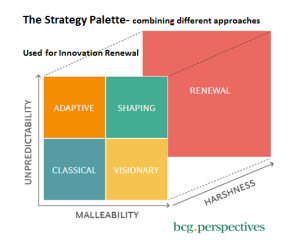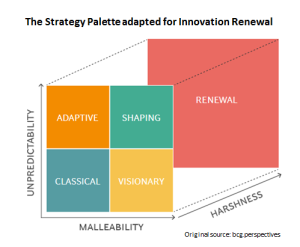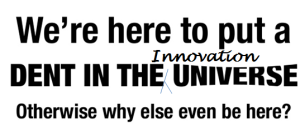 So after a fairly ‘dark’ period for me, of absorbing and reflecting on a series of reports, each indicating that innovation and its management understanding is not as deeply understood in the boardroom as it should be, you need to respond.
So after a fairly ‘dark’ period for me, of absorbing and reflecting on a series of reports, each indicating that innovation and its management understanding is not as deeply understood in the boardroom as it should be, you need to respond.
This seems an appropriate time to begin to rethink and explain innovation, partly in this need to fight these “immune systems” in fresh ways and partly to redrawn, re-frame and renew the value of innovation; in how it can help organizations going forward in very volatile times.
So let’s shine some light on new ways or even recognized paths for innovation to re-enter the thinking within our corporate boardrooms, in different ways that might resonate more in these more ‘dynamic’ times.
I like this organizing framework shown above, it can allow us to gain a revised understanding of how innovation can be mobilized in different ways, to give value in dealing with these different forces to help move you towards a growing level of renewal.
So I want to begin a series of posts around positioning innovation frameworks, tools or approaches that build the boardroom “innovation toolkit” to deal in both the predictive and unpredictive environments. The suggestions that will be offered are designed to help tackle the disruptive forces swirling around the business that are rising, increasing the uncertainties to future invest. It is attempting to address the concerns on how to organize the “forces of innovation” to combat them, to raise the confidence level in the boardroom to ’embrace’ innovation far more than seemingly the case today.
Firstly the background to this attempt to re-frame the innovation value proposition.
What prompts this has been a spate of recent reports raising concerns largely about innovation uncertainty in our boardrooms. This made me draw back and reflect, now it is time to re-frame and renew the message of innovation and its management..
The three previous posts that reflected this ‘dark period’ for innovation come out of different reports. My posts are here, here, and here. I did got fairly emotional in firstly reading the reports, and then in these three reviews – my dark period but rightly so, I believe.
The story so far if you have not read my previous three posts
The case has been made that our boards are risk-adverse, experimentally shy and digitally inept. They are struggling to adjust to the disruptive forces attacking the core of their businesses.Can that be challenged and certainly changed?
Boards feel their organizations are slow to respond, far from agile and flexible, delivering up a series of poor levels of innovation performance in the solutions to grow the business. Our boards are equally not encouraged to change the business models and offer a new way forward, to get these significant threats ‘contained’ in different ways. In many ways innovation is moving backwards due to a risk-adverse approach, missing numerous opportunities, or just not wanting to learn from past mistakes.
You might feel this has a level of abdication and quiet acceptance to it, that the inevitable is coming towards them at higher speeds and complexity than they can ever imagine. This has left them poorly equipped to manage this growing set of disrupting forces in ways they have been used too, it is creating a high level of uncertainty and uneven attempts to undertake the changes necessary. Increasingly this management rigidity within the present management style, continues to favor efficiency and effectiveness through repeating practices, processes and highly structured systems. Those are designed to extract the maximum from constantly reducing the minimum needed to get the job done.
Well you are right, many of our boards are simply incapable to think beyond their past management experiences, one that is focusing on leveraging a return for each quarter to yield ever-improving short-term results, pushing ‘incentives’ that everyone is encouraged to sign up too, for supporting this approach and their participation gets rewarded. Yet it can be also so different, perhaps liberating if they took a different tack.
Heading towards a promised land through innovation is certainly possible
Can we lead them out of this ‘dead end’ they seem to have found themselves in, a cul-de-sac,one they continue to drive along as this cost-driven, short-term road? Yet it can be very different, pursuing a more open freeway or highway seeking out growth, if you allow imagination, beliefs, determination and character to find that alternative pathway by having that real desire to make all the changes necessary, and there are many, let’s be clear upfront.
It is a journey not for the weak-willed or one undertaken half-halfheartedly but with real innovation intent and purpose.Each journey is unique but full of commonalities and these need to be revisited or explored in fresh ways. Embracing innovation fully can propel you forward, in often many unexpected ways but also in some bold and thoughtful ones.
So where do we start?
So in a series of blog-posts, I want to “shine innovation into the corporate boardrooms,” I am hopefully offering a way forward for those time-starved or presently not as well-equipped to pull this innovation structure together into a more cohesive ‘whole’ that can raise their confidence in innovation and grow in their engagement to this emerging discipline.
 The framework here, I will be breaking down in my own innovative way, as my approach to strategic innovation thinking. This is different from the way that BCG is suggesting using this framework although their title “Your strategy needs a strategy” certainly brought me to their Strategy Palette as my framing concept.
The framework here, I will be breaking down in my own innovative way, as my approach to strategic innovation thinking. This is different from the way that BCG is suggesting using this framework although their title “Your strategy needs a strategy” certainly brought me to their Strategy Palette as my framing concept.
The difference is that mine is an Innovation Strategic Palette by applying its use in developing the innovation strategic content that boardrooms require to build better, clearer and far more comprehensive innovation strategies. So I am adapting it specifically to innovation and the outcome is through these four archetypes that is leading to ‘arriving’ at renewal, for a greater chance of survival in today’s more disruptive world.
This frame will determine most of the content of the posts going forward.
The management of innovation needs organizing.
The intent of applying this innovation palette is to encourage, through the proper management of innovation, to provide and convince the boards’ they can develop a greater appetite for growth, even in increasingly disruptive times. Innovation should have a very high strategic importance on the board’s agenda, I am hopefully this contribution can help.
We need to change the thinking around the present attitudes to innovation engagement at boardroom level, in changing the risk profiles and tolerance of failure. The options to innovation should be made up of a healthy mix of extending the existing business, strengthening and extracting from this core, to find the time and resources so as to provide a greater strategic intent to find more distinctive innovations, that give a confidence in the future, as well as be fully supportive, provide encouragement and determined commitment to explore the future, where more radical and breakthrough innovation potential ‘resides.’
From what I have seen and read there seems a clear need to address the skill-set at board level to handle innovation, to equate to digital disruption and technology differently. The real urgency is to encourage board members to act far more proactively through managing innovation, to evolve and utilize a Boardroom innovation toolkit that can be built.
 The business world is far more risky today, far more complex, we are becoming more failure tolerant or ultra defensive. Innovation thrives in the unknown and undiscovered innovation territory, waiting to be explored and exploited.
The business world is far more risky today, far more complex, we are becoming more failure tolerant or ultra defensive. Innovation thrives in the unknown and undiscovered innovation territory, waiting to be explored and exploited.
Noble aim, willing intent. Lets see if I can make a dent in the innovation universe for corporate leaders.
It is being equipped with the right toolkit of innovation management that perhaps board members can then start seeing themselves as new business development leaders, that has innovation at the heart of their future decisions.
Hi Paul, I really enjoyed your post and plan to read more of your work. Like you, I did a deep dive during a two year sabbatical so as to better understand all the factors driving change and the impacts on business. I never intended it to be two years but so much was changing I stayed enthralled as I read 8 books and about 20 reports by Gartner, Deloitte, Aberdeen and others. My background in innovation comes from a career in design and marketing that I extended across PR and sales, R&D and service and very rare experience within HP and Agilent as a lone force to challenge the status quo while earning trust and delivering ROI from 4X to 15X expectations. When I pushed HP to increase the value of its brand, I was told the brand strategy was geared to protect itself from poor implementation, rather than to enable brand experts like myself to help it fly. Yeah $100M minimally in one year to $7B also in one year was what I returned with no exceptions yet the engineering culture took it for granted. Most technology companies suffer the same gaps today.. Every time I went to a boss who was an engineer, they said “it’s your job on the line, if you believe in it, do it” . I suspect that is what you see – even worse – in the boardrooms as most find what got them here has no bearing on what it takes to move forward. Some take that personally and resist change as a threat.
I believe tighter correlations can be made between innovation and profitable growth yet I also know why many innovation efforts fail. Startups show between a 20-30% success rate and intrapreneurial efforts in large companies also seem to have a high fail rate.
I have been looking to help others who are innovation advisors as the problem is bigger than just innovation. You already figured out it is leadership and even more conservative boardrooms. This last December Gallup announced that 77% of US workers (87% internationally) are emotionally detached from work and they do not feel their ideas are listened to. Ironically, three months later Gartner announced that CEO’s are ranking inclusion as their top need. Employees want to be heard and part of the planning process. Organizations with disgruntled employees are the walking dead as no way will customers ever be satisfied.
I see marketing as being in the best position – not as it has been practiced but my view of it is as a catalyst to organization alignment, buy in, customer centricity and innovation. People powered communities will only grow in power and influence. With total transparency, companies any margin less than genuine will fail faster.
This is a time of unprecedented opportunity to create inclusion, a purpose that bonds people internally and externally, and integrated thinking (systems thinking and ecosystems thinking) are critical as there is no more pinpointing the problem. There is a system that has to be understood, respected and regard earned. This is a time where humility is a strength as leaders who have it are approachable. This is a human-centric revolution and those that resist and hold on to false notions are the riskiest of all.
I pitch this as a time when stability will follow embracing the value economy sooner.
There are many types of innovation so I am constructing a perpetual innovation engine so more companies see opportunities that about 99% miss or are too slow to act on.
Look forward to reading more of your posts. Love to chat someday. I also see a day where markets can proactively innovate where companies fail to. Best, Bill Van Eron.